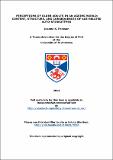Files in this item
Perceptions of older adults in an ageing world : content, structure, and consequences of age-related auto-stereotypes
Item metadata
| dc.contributor.advisor | MacLeod, Malcolm D. | |
| dc.contributor.advisor | Dritschel, Barbara | |
| dc.contributor.author | Persson, Joanne K. | |
| dc.coverage.spatial | 340 | en_US |
| dc.date.accessioned | 2015-07-28T14:30:03Z | |
| dc.date.available | 2015-07-28T14:30:03Z | |
| dc.date.issued | 2014-06-24 | |
| dc.identifier.uri | https://hdl.handle.net/10023/7056 | |
| dc.description.abstract | The current thesis explored participants’ stereotypes and auto-stereotypes of old age within the UK, and the consequences of auto-stereotype activation on older adults’ memory performance and well-being. Study 1 employed a questionnaire design to explore young (aged 17-25 years) and older adults’ (aged 60-75 years) experiences and stereotypes of ageing. Older participants demonstrated high subjective age bias, reporting subjective ages significantly below their chronological age. Older adults also demonstrated a greater understanding of positive aspects of old age than young adults, although no significant differences emerged between cohorts over the valence of generated stereotype content. Study 2 modified the questionnaire to further differentiate between more positive versus less negative aspects of ageing. Findings indicated that although older adults displayed less negative perceptions of old age than young adults, they did not demonstrate more positive representations. Study 3 explored the structure (as opposed to content) of age-related stereotypes using a free-sorting task, and included old-old adult participants (aged 75-91 years). Confirming previous findings, subtype structure formed two high level clusters, consisting of positive or negative categories. Old-old adults demonstrated the most complex subtype structure from the three groups, with no significant differences emerging between young and older adults. Finally, Study 4 employed a subliminal priming paradigm to examine the impact of positive or negative auto-stereotype activation on older adults’ memory performance and well-being. Findings suggested that negative auto-stereotype activation had a detrimental impact on participants’ memory performance, although the low power of the study means additional work is required to confirm this effect pattern. No significant effects of priming emerged for young adults. In summary, the current findings suggest that stereotypes and auto-stereotypes of old age are complex, consisting of both positive and negative elements, and point to the importance of considering subjective, rather than chronological age when assessing age-related identity. | en_US |
| dc.language.iso | en | en_US |
| dc.publisher | University of St Andrews | |
| dc.rights | Creative Commons Attribution-NonCommercial-NoDerivatives 4.0 International | |
| dc.rights.uri | http://creativecommons.org/licenses/by-nc-nd/4.0/ | |
| dc.subject | Ageing | en_US |
| dc.subject | Stereotypes | en_US |
| dc.subject | Auto-stereotypes | en_US |
| dc.subject | Memory | en_US |
| dc.subject | Age-based identity | en_US |
| dc.subject | Social cognition | en_US |
| dc.subject.lcc | BF724.85S43P4 | |
| dc.subject.lcsh | Self-perception in old age | en_US |
| dc.subject.lcsh | Identity (Psychology) in old age | en_US |
| dc.subject.lcsh | Stereotypes (Social psychology) | en_US |
| dc.subject.lcsh | Memory in old age | en_US |
| dc.subject.lcsh | Memory--Testing | en_US |
| dc.title | Perceptions of older adults in an ageing world : content, structure, and consequences of age-related auto-stereotypes | en_US |
| dc.type | Thesis | en_US |
| dc.type.qualificationlevel | Doctoral | en_US |
| dc.type.qualificationname | PhD Doctor of Philosophy | en_US |
| dc.publisher.institution | The University of St Andrews | en_US |
This item appears in the following Collection(s)
Except where otherwise noted within the work, this item's licence for re-use is described as Creative Commons Attribution-NonCommercial-NoDerivatives 4.0 International
Items in the St Andrews Research Repository are protected by copyright, with all rights reserved, unless otherwise indicated.


